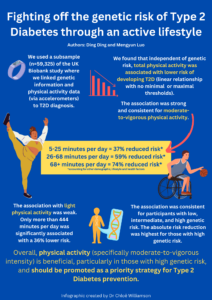This blog provides a summary of a recent study published in BJSM.
Why is this study important?
Diabetes affects more than 10% of the world’s population and it is one of the most common chronic diseases in the 21st century (1). Diabetes can lead to serious disease complications, disabilities, and premature deaths (2), and burden our healthcare systems, the economy and society (1). Type 2 diabetes (T2D) accounts for the large majority of all diabetes and is a result of multiplicative risk factors, such as genetics, obesity, diet and physical activity (3).
Physical activity has long been considered a first-line strategy for T2D prevention. However, the current evidence relied almost exclusively on questionnaire data, which are ‘coarse’ and subject to biases. Important questions, such as the role of light-intensity physical activity in T2D prevention, could not be answered sufficiently with questionnaire data.
Another important research gap is how genetic risk and physical activity interact in the onset of T2D. T2D has a strong genetic basis and hundreds of genetic variants have been identified to date (4). It is unclear, however, whether the benefits of physical activity differ by genetic risk. Such evidence could be useful to healthcare professionals and inform diabetes prevention programs around the world.
How did the study go about this?
We used data from a subsample of the UK Biobank study. A total of 59,325 apparently healthy participants with no prior diagnosis of T2D provided both accelerometer (which continuously recorded physical activity during the data collection period of seven days) and genetic data. We classified participants into low, medium, and high genetic risk based on a polygenic risk score comprised of 424 selected single nucleotide polymorphisms (SNPs). Using a validated machine learning algorithm, we quantified accelerometer data into moderate-to-vigorous intensity physical activity (MVPA; which refers to activities that get one to sweat and at least slightly out-of-breath, such as brisk walking and running) and light-intensity physical activity (such as slow walking and stretching). T2D cases were determined from various sources, such as outpatient records, GP data, and blood tests.
What did the study find?
Our study revealed several main findings (5).
First, we found a strong protective association between MVPA and T2D risk, where participants in the most active group (top 10%, >68 min/day) had 26% of the risk compared with the least active group (bottom 10%, <6 min/day) when other factors, including the genetic risk, were accounted for. This association appeared stronger than those from previous studies using self-reported physical activity. Light-intensity physical activity seemed to convey benefits as well, however, only at an extremely high level (>444 min/day) and the association was much weaker.
Second, contrary to previous studies using self-reported physical activity, we found a linear dose-response relationship between MVPA and T2D risk. This implies no minimal or maximal threshold so that any amount of MVPA could be beneficial, and the benefits continue to increase as MVPA increases without reaching an obvious diminishing point.
Third, genetic risk score strongly predicts T2D. Participants in the high genetic risk group had 2.4 times the risk of developing T2D compared with those in the low genetic risk group. The protective effects of MVPA persisted across genetic risk groups. In fact, participants with high genetic risk and high levels of physical activity appeared to have lower T2D risk compared to those with low genetic risk and low levels of physical activity. Our study also found that the largest absolute risk reduction from MVPA occurred in those with the highest genetic risk.
What are the key take-home points?
Our study suggests that physical activity, particularly MVPA, should be promoted as an important strategy for T2D prevention. To prevent the onset of T2D, any amount of MVPA could be beneficial, and the more activity, the better. It is important for clinicians, health educators and public health professionals to reinforce the importance of physical activity in T2D prevention. Although one can not change their genetic risk, our study suggests that by living an active lifestyle, one can significantly reduce the risk of developing T2D, particularly in those with high genetic risk.

Author information
Ding Ding, Mengyun Luo
Twitter: @DrMelodyDing @SusanLuo1
Sydney School of Public Health, Faculty of Medicine and Health, the University of Sydney
This blog provides an overview of a recently published study on the associations of physical activity and genetic risk with type 2 diabetes.
References
- Sun H, Saeedi P, Karuranga S, et al. IDF Diabetes Atlas: Global, regional and country-level diabetes prevalence estimates for 2021 and projections for 2045. Diabetes Res Clin Pract 2022;183:109119. doi: https://doi.org/10.1016/j.diabres.2021.109119
- Heald AH, Stedman M, Davies M, et al. Estimating life years lost to diabetes: outcomes from analysis of National Diabetes Audit and Office of National Statistics data. Cardiovascular Endocrinology & Metabolism 2020;9(4):183.
- Forouhi NG, Wareham NJ. Epidemiology of diabetes. Medicine (Baltimore) 2019;47(1):22-27. doi: https://doi.org/10.1016/j.mpmed.2018.10.004
- Mahajan A, Taliun D, Thurner M, et al. Fine-mapping type 2 diabetes loci to single-variant resolution using high-density imputation and islet-specific epigenome maps. Nat Genet 2018;50(11):1505-13. doi: 10.1038/s41588-018-0241-6
- Mengyun L, Chenhao Y, Borja Del Pozo C, et al. Accelerometer-measured intensity-specific physical activity, genetic risk and incident type 2 diabetes: a prospective cohort study. Br J Sports Med 2023:bjsports-2022-106653. doi: 10.1136/bjsports-2022-106653